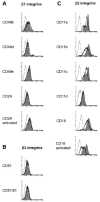S100A9 mediates neutrophil adhesion to fibronectin through activation of beta2 integrins
- PMID: 17222807
- PMCID: PMC1865105
- DOI: 10.1016/j.bbrc.2006.12.203
S100A9 mediates neutrophil adhesion to fibronectin through activation of beta2 integrins
Abstract
Neutrophil migration from the blood to inflammatory sites follows a cascade of events, in which adhesion to endothelial cells and extracellular matrix proteins is essential. S100A8, S100A9, and S100A12 are small abundant proteins found in human neutrophil cytosol and presumed to be involved in leukocyte migration. Here we investigated the S100 proteins' activities in neutrophil tissue migration by evaluating their effects on neutrophil adhesion to certain extracellular matrix proteins. S100A9 induced adhesion only to fibronectin and was the only S100 protein that stimulated neutrophil adhesion to this extracellular matrix protein. Experiments with blocking antibodies revealed that neither beta1 nor beta3 integrins were strongly involved in neutrophil adhesion to fibronectin, contrary to what the literature predicted. In contrast, neutrophil adhesion to fibronectin was completely inhibited by anti-beta2 integrins, suggesting that S100A9-induced specific activation of beta2 integrin is essential to neutrophil adhesion.
Figures



Similar articles
-
Cytohesin-1 regulates human blood neutrophil adhesion to endothelial cells through β2 integrin activation.Mol Immunol. 2011 Jul;48(12-13):1408-16. doi: 10.1016/j.molimm.2011.03.018. Epub 2011 Apr 20. Mol Immunol. 2011. PMID: 21511340
-
Proinflammatory activities of S100: proteins S100A8, S100A9, and S100A8/A9 induce neutrophil chemotaxis and adhesion.J Immunol. 2003 Mar 15;170(6):3233-42. doi: 10.4049/jimmunol.170.6.3233. J Immunol. 2003. PMID: 12626582
-
Adhesion of neutrophils to fibronectin: role of the cd66 antigens.Cell Immunol. 2001 Mar 15;208(2):96-106. doi: 10.1006/cimm.2001.1772. Cell Immunol. 2001. PMID: 11333142
-
β2 Integrin Signaling Cascade in Neutrophils: More Than a Single Function.Front Immunol. 2021 Feb 18;11:619925. doi: 10.3389/fimmu.2020.619925. eCollection 2020. Front Immunol. 2021. PMID: 33679708 Free PMC article. Review.
-
Integrins in cell adhesion and signaling.Hum Cell. 1996 Sep;9(3):181-6. Hum Cell. 1996. PMID: 9183647 Review.
Cited by
-
The effects of extracellular matrix proteins on neutrophil-endothelial interaction--a roadway to multiple therapeutic opportunities.Yale J Biol Med. 2012 Jun;85(2):167-85. Epub 2012 Jun 25. Yale J Biol Med. 2012. PMID: 22737047 Free PMC article. Review.
-
Assessment of Arf6 Deletion in PLB-985 Differentiated in Neutrophil-Like Cells and in Mouse Neutrophils: Impact on Adhesion and Migration.Mediators Inflamm. 2020 Apr 7;2020:2713074. doi: 10.1155/2020/2713074. eCollection 2020. Mediators Inflamm. 2020. PMID: 32322163 Free PMC article.
-
Monocyte Migration Driven by Galectin-3 Occurs through Distinct Mechanisms Involving Selective Interactions with the Extracellular Matrix.ISRN Inflamm. 2013 Feb 25;2013:259256. doi: 10.1155/2013/259256. eCollection 2013. ISRN Inflamm. 2013. PMID: 24049657 Free PMC article.
-
S100A8 and S100A9 induce cytokine expression and regulate the NLRP3 inflammasome via ROS-dependent activation of NF-κB(1.).PLoS One. 2013 Aug 19;8(8):e72138. doi: 10.1371/journal.pone.0072138. eCollection 2013. PLoS One. 2013. PMID: 23977231 Free PMC article.
-
Inhibition of intestinal polyp growth by oral ingestion of bovine lactoferrin and immune cells in the large intestine.Biometals. 2014 Oct;27(5):1017-29. doi: 10.1007/s10534-014-9747-2. Epub 2014 May 28. Biometals. 2014. PMID: 24867408 Free PMC article. Clinical Trial.
References
-
- Hessian PA, Edgeworth J, Hogg N. MRP-8 and MRP-14, two abundant Ca(2+)-binding proteins of neutrophils and monocytes. J. Leukoc. Biol. 1993;53:197–204. - PubMed
-
- Hunter MJ, Chazin WJ. High level expression and dimer characterization of the S100 EF-hand proteins, migration inhibitory factor-related proteins 8 and 14. J. Biol. Chem. 1998;273:12427–12435. - PubMed
-
- Strasser F, Gowland PL, Ruef C. Elevated serum macrophage inhibitory factor-related protein (MRP) 8/14 levels in advanced HIV infection and during disease exacerbation. J. Acquir. Immune. Defic. Syndr. Hum. Retrovirol. 1997;16:230–238. - PubMed
-
- Odink K, Cerletti N, Bruggen J, Clerc RG, Tarcsay L, Zwadlo G, Gerhards G, Schlegel R, Sorg C. Two calcium-binding proteins in infiltrate macrophages of rheumatoid arthritis. Nature. 1987;330:80–82. - PubMed
Publication types
MeSH terms
Substances
Grants and funding
LinkOut - more resources
Full Text Sources
Research Materials
Miscellaneous

